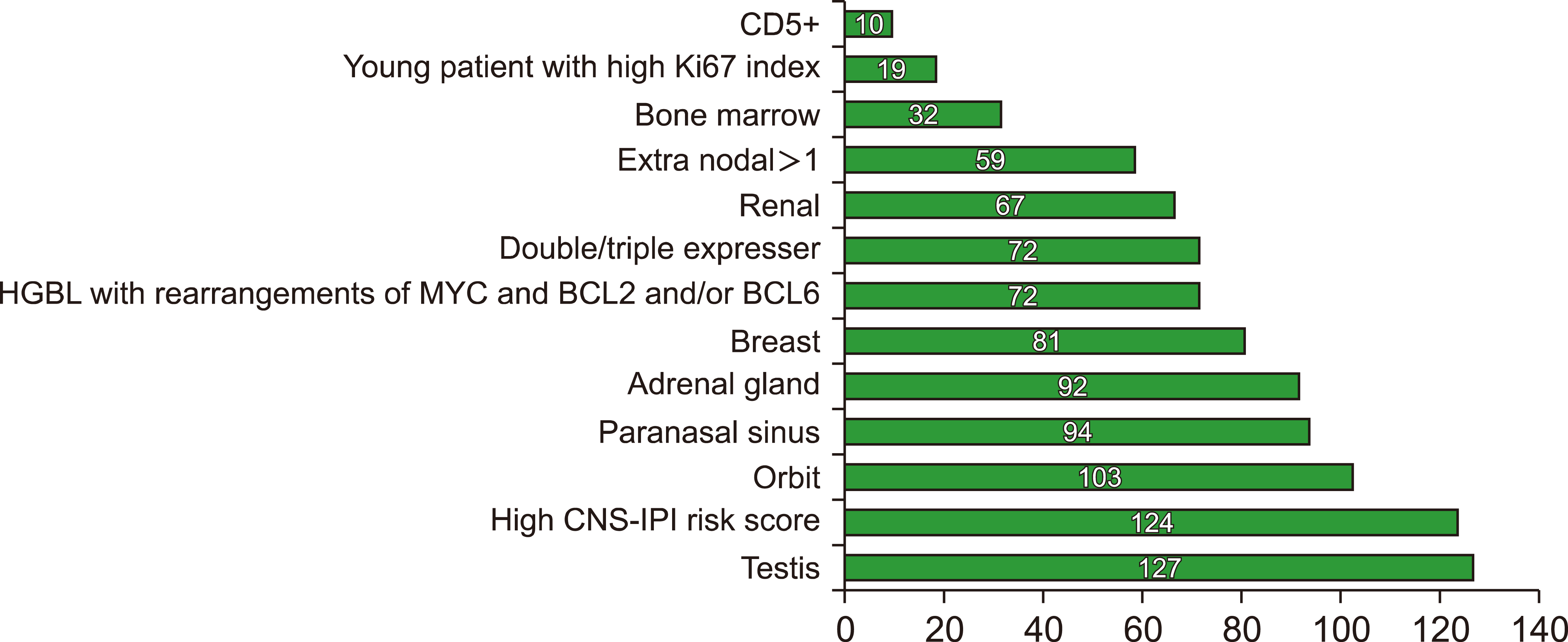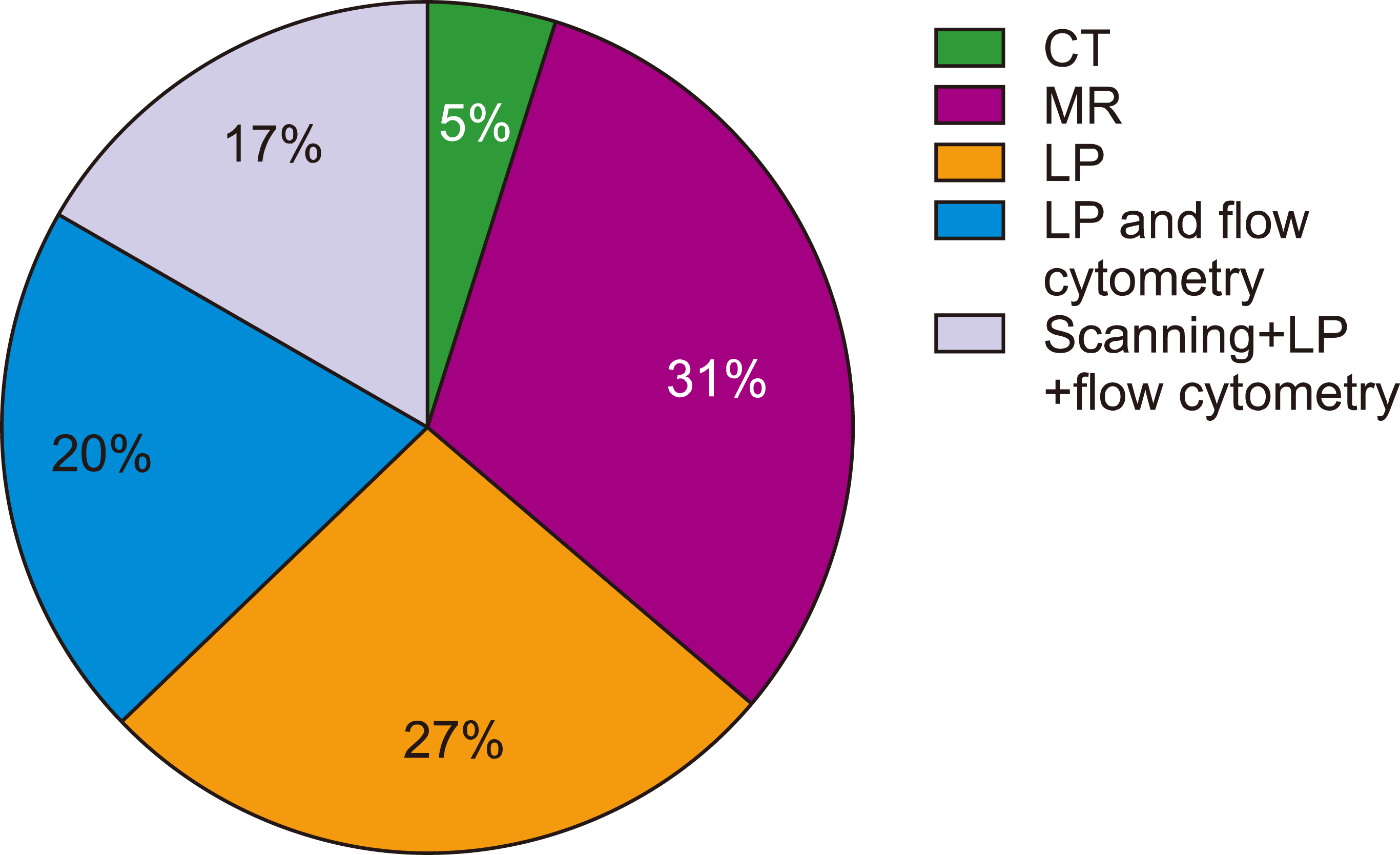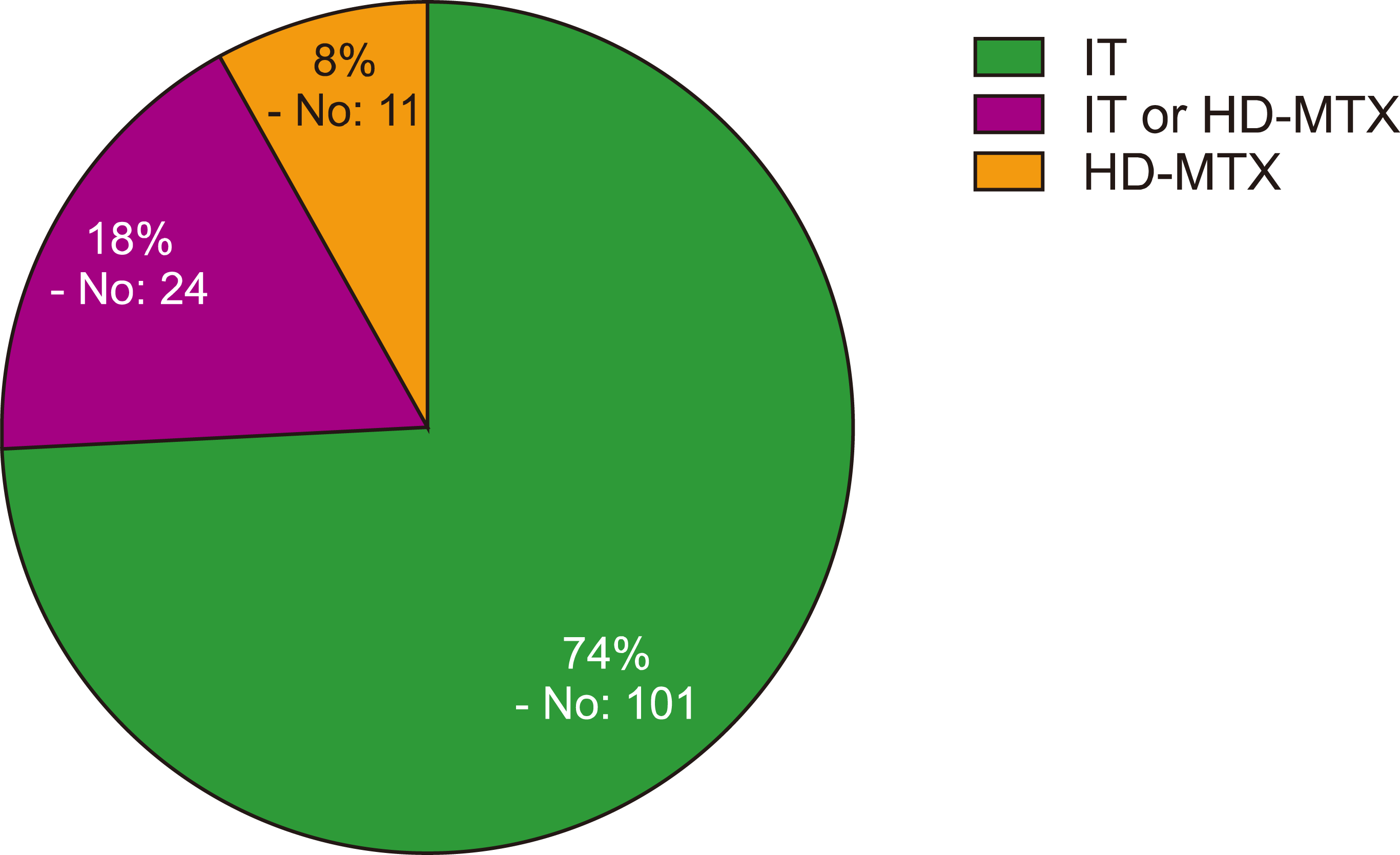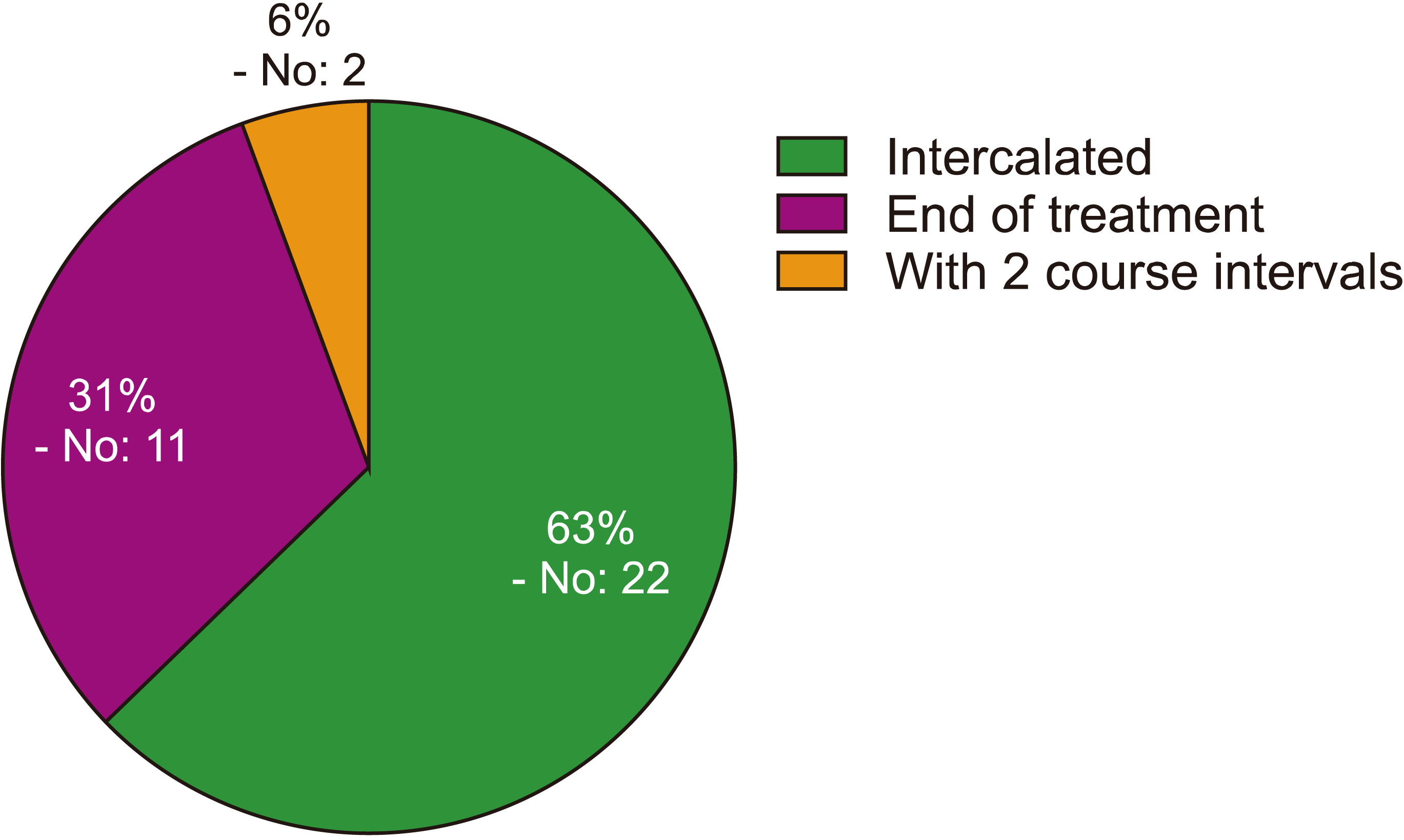1. Doolittle ND, Abrey LE, Shenkier TN, et al. 2008; Brain parenchyma involvement as isolated central nervous system relapse of systemic non-Hodgkin lymphoma: an International Primary CNS Lymphoma Collaborative Group report. Blood. 111:1085–93. DOI:
10.1182/blood-2007-07-101402. PMID:
17962515.

2. Bierman P, Giglio P. 2005; Diagnosis and treatment of central nervous system involvement in non-Hodgkin's lymphoma. Hematol Oncol Clin North Am. 19:597–609. DOI:
10.1016/j.hoc.2005.05.003. PMID:
16083825.

4. Zahid MF, Khan N, Hashmi SK, Kizilbash SH, Barta SK. 2016; Central nervous system prophylaxis in diffuse large B-cell lymphoma. Eur J Haematol. 97:108–20. DOI:
10.1111/ejh.12763. PMID:
27096423.

5. Boehme V, Schmitz N, Zeynalova S, Loeffler M, Pfreundschuh M. 2009; CNS events in elderly patients with aggressive lymphoma treated with modern chemotherapy (CHOP-14) with or without rituximab: an analysis of patients treated in the RICOVER-60 trial of the German High-Grade Non-Hodgkin Lymphoma Study Group (DSHNHL). Blood. 113:3896–902. DOI:
10.1182/blood-2008-10-182253. PMID:
19144985.

6. Feugier P, Virion JM, Tilly H, et al. 2004; Incidence and risk factors for central nervous system occurrence in elderly patients with diffuse large-B-cell lymphoma: influence of rituximab. Ann Oncol. 15:129–33. DOI:
10.1093/annonc/mdh013. PMID:
14679132.
7. Calimeri T, Lopedote P, Ferreri AJM. 2019; Risk stratification and management algorithms for patients with diffuse large B-cell lymphoma and CNS involvement. Ann Lymphoma. 3:7. DOI:
10.21037/aol.2019.06.01.

8. Schmitz N, Zeynalova S, Nickelsen M, et al. 2016; CNS international prognostic index: a risk model for CNS relapse in patients with diffuse large B-cell lymphoma treated with R-CHOP. J Clin Oncol. 34:3150–6. DOI:
10.1200/JCO.2015.65.6520. PMID:
27382100.

9. Nitta H, Terui Y, Yokoyama M, et al. 2015; Absolute peripheral monocyte count at diagnosis predicts central nervous system relapse in diffuse large B-cell lymphoma. Haematologica. 100:87–90. DOI:
10.3324/haematol.2014.114934. PMID:
25261092. PMCID:
PMC4281317.

10. McKay P, Wilson MR, Chaganti S, Smith J, Fox CP, Cwynarski K. 2020; The prevention of central nervous system relapse in diffuse large B-cell lymphoma: a British Society for Haematology good practice paper. Br J Haematol. 190:708–14. DOI:
10.1111/bjh.16866. PMID:
32433789.

12. Kridel R, Telio D, Villa D, et al. 2017; Diffuse large B-cell lymphoma with testicular involvement: outcome and risk of CNS relapse in the rituximab era. Br J Haematol. 176:210–21. DOI:
10.1111/bjh.14392. PMID:
27739058.

13. Villa D, Connors JM, Sehn LH, Gascoyne RD, Savage KJ. 2011; Diffuse large B-cell lymphoma with involvement of the kidney: outcome and risk of central nervous system relapse. Haematologica. 96:1002–7. DOI:
10.3324/haematol.2011.041277. PMID:
21486867. PMCID:
PMC3128219.

14. El-Galaly TC, Cheah CY, Hutchings M, et al. 2016; Uterine, but not ovarian, female reproductive organ involvement at presentation by diffuse large B-cell lymphoma is associated with poor outcomes and a high frequency of secondary CNS involvement. Br J Haematol. 175:876–83. DOI:
10.1111/bjh.14325. PMID:
27681999.

16. Fukuhara S, Watanabe T, Munakata W, et al. 2011; Bulky disease impacts outcomes in primary diffuse large B-cell lymphoma of the breast: a retrospective analysis at a single institution. Eur J Haematol. 87:434–40. DOI:
10.1111/j.1600-0609.2011.01679.x. PMID:
21740461.
17. Shimada K, Murase T, Matsue K, et al. 2010; Central nervous system involvement in intravascular large B-cell lymphoma: a retro-spective analysis of 109 patients. Cancer Sci. 101:1480–6. DOI:
10.1111/j.1349-7006.2010.01555.x. PMID:
20412122.

18. McMillan A, Ardeshna KM, Cwynarski K, Lyttelton M, McKay P, Montoto S. 2013; Guideline on the prevention of secondary central nervous system lymphoma: British Committee for Standards in Haematology. Br J Haematol. 163:168–81. DOI:
10.1111/bjh.12509. PMID:
24033102.

19. Savage KJ. 2017; Secondary CNS relapse in diffuse large B-cell lymphoma: defining high-risk patients and optimization of prophylaxis strategies. Hematology Am Soc Hematol Educ Program. 2017:578–86. DOI:
10.1182/asheducation-2017.1.578. PMID:
29222307. PMCID:
PMC6142549.

20. Miyazaki K, Yamaguchi M, Suzuki R, et al. 2011; CD5-positive diffuse large B-cell lymphoma: a retrospective study in 337 patients treated by chemotherapy with or without rituximab. Ann Oncol. 22:1601–7. DOI:
10.1093/annonc/mdq627. PMID:
21199885.

22. Cwynarski K, Cummin T, Osborne W, et al. 2023; Management of secondary central nervous system lymphoma. Br J Haematol. 200:160–9. DOI:
10.1111/bjh.18539. PMID:
36408800.

23. Hegde U, Filie A, Little RF, et al. 2005; High incidence of occult leptomeningeal disease detected by flow cytometry in newly diagnosed aggressive B-cell lymphomas at risk for central nervous system involvement: the role of flow cytometry versus cytology. Blood. 105:496–502. DOI:
10.1182/blood-2004-05-1982. PMID:
15358629.

24. Alvarez R, Dupuis J, Plonquet A, et al. 2012; Clinical relevance of flow cytometric immunophenotyping of the cerebrospinal fluid in patients with diffuse large B-cell lymphoma. Ann Oncol. 23:1274–9. DOI:
10.1093/annonc/mdr436. PMID:
21965472.

25. Haioun C, Besson C, Lepage E, et al. 2000; Incidence and risk factors of central nervous system relapse in histologically aggressive non-Hodgkin's lymphoma uniformly treated and receiving intrathecal central nervous system prophylaxis: a GELA study on 974 patients. Groupe d'Etudes des Lymphomes de l'Adulte. Ann Oncol. 11:685–90. DOI:
10.1023/A:1008394827806. PMID:
10942056.
26. Tomita N, Kodama F, Kanamori H, Motomura S, Ishigatsubo Y. 2002; Prophylactic intrathecal methotrexate and hydrocortisone reduces central nervous system recurrence and improves survival in aggressive non-Hodgkin lymphoma. Cancer. 95:576–80. DOI:
10.1002/cncr.10699. PMID:
12209750.

27. Tai WM, Chung J, Tang PL, et al. 2011; Central nervous system (CNS) relapse in diffuse large B cell lymphoma (DLBCL): pre- and post-rituximab. Ann Hematol. 90:809–18. DOI:
10.1007/s00277-010-1150-7. PMID:
21229246.

28. Klanova M, Sehn LH, Bence-Bruckler I, et al. 2019; Integration of cell of origin into the clinical CNS International Prognostic Index improves CNS relapse prediction in DLBCL. Blood. 133:919–26. DOI:
10.1182/blood-2018-07-862862. PMID:
30617197. PMCID:
PMC6396175.

29. Eyre TA, Djebbari F, Kirkwood AA, Collins GP. 2020; Efficacy of central nervous system prophylaxis with stand-alone intrathecal chemotherapy in diffuse large B-cell lymphoma patients treated with anthracycline-based chemotherapy in the rituximab era: a systematic review. Haematologica. 105:1914–24. DOI:
10.3324/haematol.2019.229948. PMID:
31488560. PMCID:
PMC7327624.

30. Ferreri AJ, Guerra E, Regazzi M, et al. 2004; Area under the curve of methotrexate and creatinine clearance are outcome-determining factors in primary CNS lymphomas. Br J Cancer. 90:353–8. DOI:
10.1038/sj.bjc.6601472. PMID:
14735176. PMCID:
PMC2409565.

31. Ferreri AJ, Bruno-Ventre M, Donadoni G, et al. 2015; Risk-tailored CNS prophylaxis in a mono-institutional series of 200 patients with diffuse large B-cell lymphoma treated in the rituximab era. Br J Haematol. 168:654–62. DOI:
10.1111/bjh.13194. PMID:
25312994.

33. Orellana-Noia VM, Reed DR, McCook AA, et al. 2022; Single-route CNS prophylaxis for aggressive non-Hodgkin lymphomas: real-world outcomes from 21 US academic institutions. Blood. 139:413–23. DOI:
10.1182/blood.2021012888. PMID:
34570876. PMCID:
PMC8777199.

35. Wilson MR, Eyre TA, Kirkwood AA, et al. 2022; Timing of high-dose methotrexate CNS prophylaxis in DLBCL: a multicenter international analysis of 1384 patients. Blood. 139:2499–511. DOI:
10.1182/blood.2021014506. PMID:
34995350.





 PDF
PDF Citation
Citation Print
Print







 XML Download
XML Download